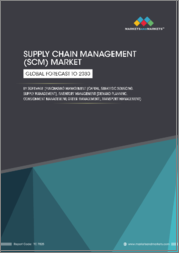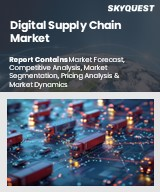
|
시장보고서
상품코드
1579008
세계의 공급망 디지털 프로세스 자동화 시장 : 부문별 예측(2025-2030년)Supply Chain Digital Process Automation Market by Components (Services, Software), Deployment Type (Cloud, On-Premises), Organization Size - Global Forecast 2025-2030 |
||||||
공급망 디지털 프로세스 자동화(Supply Chain Digital Process Automation) 시장의 2023년 시장 규모는 48억 9,000만 달러였으며, 2024년에는 53억 7,000만 달러에 이를 것으로 추정되며, CAGR 10.24%로 성장하고 2030년에는 96 8,000만 달러에 이를 것으로 예상됩니다.
공급망 디지털 프로세스 자동화(DPA)란 비즈니스 프로세스를 간소화, 최적화 및 자동화하기 위한 기술의 전략적 도입을 의미합니다. DPA의 필요성은 업무 효율성을 높이고 인적 실수를 줄이고 의사 결정 능력을 가속화 할 필요성 때문입니다. DPA는 조달, 물류, 재고 관리, 고객 서비스 등 공급망의 다양한 기능에 적용되며 궁극적으로 제조, 소매, 헬스케어, 자동차 등 업계의 최종 사용자에게 서비스를 제공합니다. DPA 시장은 세계 공급망의 복잡화, 실시간 데이터 분석 수요, AI와 머신러닝 기술의 통합에 의해 견인되고 있습니다. 주요 성장 요인으로는 기존 프로세스의 급속한 디지털화, 시장 수요에 대응하는 민첩성 향상 요구, 비용 효율성 및 부가가치 서비스를 추진하는 경쟁 격화 등이 있습니다.
| 주요 시장 통계 | |
|---|---|
| 기준연도(2023년) | 48억 9,000만 달러 |
| 추정연도(2024년) | 53억 7,000만 달러 |
| 예측연도(2030년) | 96억 8,000만 달러 |
| CAGR(%) | 10.24% |
이 시장의 잠재적인 비즈니스 기회에는 재고 관리를 위한 예측 분석 도구 개발, 공급업체 및 파트너를 위한 강화된 협업 플랫폼, 확장성 및 유연성을 제공하는 클라우드 기반 솔루션 등이 포함됩니다. 됩니다. 이러한 기회를 포착하기 위해 기업은 첨단 플랫폼을 취급할 수 있는 숙련된 인재 육성에 투자하여 AI나 DPA를 전문으로 하는 기술계 기업과의 파트너십을 확립할 필요가 있습니다. 그러나 막대한 초기 도입 비용, 기존 공급망 사업체의 변화에 대한 잠재적 저항, 사이버 보안 위험 등 제약으로 인해 시장 성장이 막힐 수 있습니다. 혁신적인 방법으로 기업은 공급망 내부의 투명성과 보안을 강화하기 위해 블록체인 기술의 통합을 모색하고, 제품의 실시간 추적 및 모니터링을 위해 IoT 장치의 활용을 파악할 수 있습니다. 수 있습니다. 시장은 역동적이고 급속한 기술 진보와 진화하는 고객의 기대를 특징으로 하며 경쟁 우위를 유지하기 위해 연구 개발에 지속적인 투자가 필요합니다. 결국 공급망에서 DPA의 미래 전망은 효율성을 더욱 변화시키고 기술적 변화에 적응하고 견고한 보안 프레임워크를 유지할 수 있는지 여부에 달려 있습니다.
시장 역학 : 빠르게 진화하는 공급망 디지털 프로세스 자동화 시장의 주요 인사이트 공개
공급망 디지털 공정 자동화 시장은 수요 및 공급의 역동적인 상호작용으로 변모하고 있습니다. 이러한 시장 역학의 진화를 이해함으로써 기업은 충분한 정보를 바탕으로 투자결정, 전략적 의사결정, 새로운 비즈니스 기회를 획득할 수 있습니다. 이러한 동향을 종합적으로 파악함으로써 기업은 정치적, 지리적, 기술적, 사회적, 경제적 영역에 걸친 다양한 위험을 완화할 수 있으며, 소비자 행동과 그것이 제조 비용과 구매 동향에 미치는 영향을보다 명확하게 이해할 수 있습니다.
- 시장 성장 촉진요인
- 디지털 프로세스 자동화의 유효 활용에 의한 공급망 업무의 합리화와 비용 절감
- 업무 효율을 높이기 위한 공급망 업계에서 첨단 기술 채택 확대
- 공급망 관리에서 실시간 데이터 가시성과 분석 기능에 대한 요구 증가
- 디지털 프로세스 자동화을 통한 고객 수요 대응 및 서비스 제공 개선 압력
- 시장 성장 억제요인
- 고급 디지털 프로세스 자동화 기술을 다루는 숙련 노동력 부족은 공급망 시장에 영향
- 시장 기회
- 공급망 가시성과 공정 효율 향상을 위한 AI 기반 솔루션 활용
- 안전하고 투명한 공급망 거래를 위한 블록체인 기술 도입
- 공급망에 있어서 예지보전과 수요 예측을 위한 고도의 애널리틱스의 활용
- 시장 과제
- 조직 내의 변화에 대한 저항이 공급망 관리에 있어서 디지털 프로세스 자동화의 채택률의 둔화로 이어짐
Portre's Five Forces : 공급망 디지털 프로세스 자동화 시장을 탐색하는 전략 도구
Porter's Five Forces 프레임워크는 시장 상황경쟁 구도를 이해하는 중요한 도구입니다. Porter's Five Forces 프레임워크는 기업의 경쟁력을 평가하고 전략적 기회를 탐구하는 명확한 기술을 제공합니다. 이 프레임워크는 기업이 시장 내 세력도를 평가하고 신규 사업의 수익성을 결정하는 데 도움이 됩니다. 이러한 통찰을 통해 기업은 자사의 강점을 활용하고, 약점을 해결하고, 잠재적인 과제를 피할 수 있으며, 보다 강인한 시장에서 포지셔닝을 보장할 수 있습니다.
PESTLE 분석 : 공급망 디지털 프로세스 자동화 시장에서 외부 영향을 파악
외부 거시 환경 요인은 공급망 디지털 프로세스 자동화 시장의 성과 역학을 형성하는 데 매우 중요한 역할을합니다. 정치적, 경제적, 사회적, 기술적, 법적, 환경적 요인 분석은 이러한 영향을 탐색하는 데 필요한 정보를 제공합니다. PESTLE 요인을 조사함으로써 기업은 잠재적인 위험과 기회를 더 잘 이해할 수 있습니다. 이 분석을 통해 기업은 규제, 소비자 선호, 경제 동향의 변화를 예측하고 앞으로 예상되는 적극적인 의사 결정을 할 준비를 할 수 있습니다.
시장 점유율 분석 : 공급망 디지털 프로세스 자동화 시장 경쟁 구도 파악
공급망 디지털 프로세스 자동화 시장의 상세한 시장 점유율 분석을 통해 공급업체의 성과를 종합적으로 평가할 수 있습니다. 기업은 수익, 고객 기반, 성장률 등 주요 지표를 비교하여 경쟁 포지셔닝을 밝힐 수 있습니다. 이 분석을 통해 시장 집중, 단편화 및 통합 동향을 밝혀내고 공급업체는 경쟁이 치열해지면서 자신의 입지를 높이는 전략적 의사 결정을 내리는 데 필요한 지식을 얻을 수 있습니다.
FPNV 포지셔닝 매트릭스 : 공급망, 디지털 프로세스 자동화 시장에서 공급업체의 성과 평가
FPNV 포지셔닝 매트릭스는 공급망 디지털 프로세스 자동화 시장에서 공급업체를 평가하는 중요한 도구입니다. 이 매트릭스를 통해 비즈니스 조직은 공급업체의 비즈니스 전략과 제품 만족도를 기준으로 평가하여 목표에 맞는 충분한 정보를 바탕으로 의사 결정을 내릴 수 있습니다. 네 가지 사분면을 통해 공급업체를 명확하고 정확하게 부문화하고 전략 목표에 가장 적합한 파트너 및 솔루션을 파악할 수 있습니다.
전략 분석 및 추천 : 공급망 디지털 프로세스 자동화 시장에서 성공에 대한 길
공급망 디지털 프로세스 자동화 시장의 전략 분석은 시장에서 존재를 강화하려는 기업에게 필수적입니다. 주요 자원, 역량 및 성과 지표를 검토함으로써 기업은 성장 기회를 파악하고 개선을 위해 노력할 수 있습니다. 이러한 접근 방식을 통해 경쟁 구도에서 과제를 극복하고 새로운 비즈니스 기회를 활용하여 장기적인 성공을 거둘 수 있는 체제를 구축할 수 있습니다.
이 보고서는 주요 관심 분야를 포괄하는 시장의 종합적인 분석을 제공합니다.
1. 시장 침투 : 현재 시장 환경의 상세한 검토, 주요 기업의 광범위한 데이터, 시장 도달범위 및 전반적인 영향력을 평가합니다.
2. 시장 개척도 : 신흥 시장 성장 기회를 파악하고 기존 분야의 확장 가능성을 평가하며 미래 성장을 위한 전략적 로드맵을 제공합니다.
3. 시장 다양화 : 최근 제품 출시, 미개척 지역, 업계의 주요 진보, 시장을 형성하는 전략적 투자를 분석합니다.
4. 경쟁 평가 및 정보 : 경쟁 구도를 철저히 분석하여 시장 점유율, 사업 전략, 제품 포트폴리오, 인증, 규제 당국 승인, 특허 동향, 주요 기업의 기술 진보 등을 검증합니다.
5. 제품 개발 및 혁신 : 미래 시장 성장을 가속할 것으로 예상되는 최첨단 기술, R&D 활동, 제품 혁신을 강조합니다.
또한 이해관계자가 충분한 정보를 얻고 의사결정을 할 수 있도록 중요한 질문에 대답하고 있습니다.
1. 현재 시장 규모와 향후 성장 예측은?
2. 최고의 투자 기회를 제공하는 제품, 부문 및 지역은?
3. 시장을 형성하는 주요 기술 동향과 규제의 영향은?
4. 주요 벤더의 시장 점유율과 경쟁 포지션은?
5. 벤더 시장 진입·철수 전략의 원동력이 되는 수익원과 전략적 기회는?
목차
제1장 서문
제2장 조사 방법
제3장 주요 요약
제4장 시장 개요
제5장 시장 인사이트
- 시장 역학
- 성장 촉진요인
- 디지털 프로세스 자동화을 효과적으로 활용하여 공급망 업무를 효율화하여 비용 절감
- 업무 효율을 높이기 위해 공급망 업계 내에서 선진 기술의 도입이 증가
- 공급망 관리에서 실시간 데이터 가시성과 분석 기능의 필요성 증가
- 디지털 프로세스 자동화를 통해 고객 수요를 충족하고 서비스 제공을 개선하는 압력
- 억제요인
- 고급 디지털 프로세스 자동화 기술을 다룰 수 있는 숙련 노동력 부족이 공급망 시장에 영향
- 기회
- AI 기반 솔루션을 활용하여 공급망의 가시성과 공정 효율을 향상
- 안전하고 투명한 공급망 거래를 위한 블록체인 기술 구현
- 공급망에 있어서 예지 보전과 수요 예측을 위한 고도의 분석의 활용
- 과제
- 조직의 변화에 대한 저항으로 인해 공급망 관리에서 디지털 프로세스 자동화의 도입률이 감소
- 성장 촉진요인
- 시장 세분화 분석
- Porter's Five Forces 분석
- PESTEL 분석
- 정치적
- 경제적
- 사회적
- 기술적
- 법적
- 환경적
제6장 공급망 디지털 프로세스 자동화 시장 : 컴포넌트별
- 서비스
- 실장
- 지원 및 유지 보수
- 소프트웨어
- 로봇식 프로세스 자동화
제7장 공급망 디지털 프로세스 자동화 시장 : 전개 유형별
- 클라우드
- 온프레미스
제8장 공급망 디지털 프로세스 자동화 시장 : 조직 규모별
- 대기업
- 중소기업
제9장 아메리카의 공급망 디지털 프로세스 자동화 시장
- 아르헨티나
- 브라질
- 캐나다
- 멕시코
- 미국
제10장 아시아 태평양의 공급망 디지털 프로세스 자동화 시장
- 호주
- 중국
- 인도
- 인도네시아
- 일본
- 말레이시아
- 필리핀
- 싱가포르
- 한국
- 대만
- 태국
- 베트남
제11장 유럽·중동 및 아프리카의 공급망 디지털 프로세스 자동화 시장
- 덴마크
- 이집트
- 핀란드
- 프랑스
- 독일
- 이스라엘
- 이탈리아
- 네덜란드
- 나이지리아
- 노르웨이
- 폴란드
- 카타르
- 러시아
- 사우디아라비아
- 남아프리카공화국
- 스페인
- 스웨덴
- 스위스
- 터키
- 아랍에미리트(UAE)
- 영국
제12장 경쟁 구도
- 시장 점유율 분석(2023년)
- FPNV 포지셔닝 매트릭스(2023년)
- 경쟁 시나리오 분석
- 전략 분석 및 제안
기업 목록
- Basware Corporation
- Blue Yonder Group, Inc.
- Coupa Software Inc.
- E2open, LLC
- Epicor Software Corporation
- GEP Worldwide
- HighJump(now part of Korber)
- IBM Corporation
- Infor
- Jaggaer
- JDA Software Group, Inc.(now part of Blue Yonder)
- Kinaxis Inc.
- Korber AG
- Logility, Inc.
- Manhattan Associates, Inc.
- Oracle Corporation
- QAD Inc.
- SAP SE
- Siemens AG
- The Descartes Systems Group Inc.
The Supply Chain Digital Process Automation Market was valued at USD 4.89 billion in 2023, expected to reach USD 5.37 billion in 2024, and is projected to grow at a CAGR of 10.24%, to USD 9.68 billion by 2030.
Digital Process Automation (DPA) within the supply chain refers to the strategic implementation of technology to streamline, optimize, and automate business processes. The necessity of DPA arises from the need to enhance operational efficiency, reduce human errors, and accelerate decision-making capabilities. It is applied across various functions of the supply chain, including procurement, logistics, inventory management, and customer service, ultimately servicing end-users in industries such as manufacturing, retail, healthcare, and automotive. The market for DPA is driven by the increasing complexity of global supply chains, the demand for real-time data analytics, and the integration of AI and machine learning technologies. Key growth factors include the rapid digitization of traditional processes, the need for increased agility in response to market demands, and heightened competition that drives cost efficiencies and value-added services.
| KEY MARKET STATISTICS | |
|---|---|
| Base Year [2023] | USD 4.89 billion |
| Estimated Year [2024] | USD 5.37 billion |
| Forecast Year [2030] | USD 9.68 billion |
| CAGR (%) | 10.24% |
Potential opportunities in this market include the development of predictive analytics tools for inventory management, enhanced collaboration platforms for suppliers and partners, and cloud-based solutions that offer scalability and flexibility. To seize these opportunities, companies should invest in training for skilled personnel to handle sophisticated platforms and establish partnerships with tech firms specializing in AI and DPA. However, market growth might be challenged by limitations such as high initial implementation costs, potential resistance to change from traditional supply chain entities, and cybersecurity risks. Innovatively, businesses could explore the integration of blockchain technology to enhance transparency and security within the supply chain or delve into the utilization of IoT devices for real-time tracking and monitoring of goods. The market is dynamic, characterized by rapid technological advancements and evolving customer expectations, requiring continuous investment in R&D to maintain competitive advantage. Ultimately, the future landscape of DPA in supply chains hinges on its ability to further transform efficiency, adapt to technological changes, and maintain robust security frameworks.
Market Dynamics: Unveiling Key Market Insights in the Rapidly Evolving Supply Chain Digital Process Automation Market
The Supply Chain Digital Process Automation Market is undergoing transformative changes driven by a dynamic interplay of supply and demand factors. Understanding these evolving market dynamics prepares business organizations to make informed investment decisions, refine strategic decisions, and seize new opportunities. By gaining a comprehensive view of these trends, business organizations can mitigate various risks across political, geographic, technical, social, and economic domains while also gaining a clearer understanding of consumer behavior and its impact on manufacturing costs and purchasing trends.
- Market Drivers
- Effective utilization of digital process automation to streamline supply chain operations and reduce costs
- Growing adoption of advanced technologies within the supply chain industry to enhance operational efficiency
- Increasing need for real-time data visibility and analytics capabilities in supply chain management
- Pressure to meet customer demand and improve service delivery through digital process automation
- Market Restraints
- Lack of skilled workforce capable of handling sophisticated digital process automation technologies impacting the supply chain market
- Market Opportunities
- Leveraging ai-based solutions for enhanced supply chain visibility and process efficiency
- Implementing blockchain technology for secure and transparent supply chain transactions
- Utilizing advanced analytics for predictive maintenance and demand forecasting in supply chains
- Market Challenges
- Resistance to change within organizations leads to slow adoption rates of digital process automation in supply chain management
Porter's Five Forces: A Strategic Tool for Navigating the Supply Chain Digital Process Automation Market
Porter's five forces framework is a critical tool for understanding the competitive landscape of the Supply Chain Digital Process Automation Market. It offers business organizations with a clear methodology for evaluating their competitive positioning and exploring strategic opportunities. This framework helps businesses assess the power dynamics within the market and determine the profitability of new ventures. With these insights, business organizations can leverage their strengths, address weaknesses, and avoid potential challenges, ensuring a more resilient market positioning.
PESTLE Analysis: Navigating External Influences in the Supply Chain Digital Process Automation Market
External macro-environmental factors play a pivotal role in shaping the performance dynamics of the Supply Chain Digital Process Automation Market. Political, Economic, Social, Technological, Legal, and Environmental factors analysis provides the necessary information to navigate these influences. By examining PESTLE factors, businesses can better understand potential risks and opportunities. This analysis enables business organizations to anticipate changes in regulations, consumer preferences, and economic trends, ensuring they are prepared to make proactive, forward-thinking decisions.
Market Share Analysis: Understanding the Competitive Landscape in the Supply Chain Digital Process Automation Market
A detailed market share analysis in the Supply Chain Digital Process Automation Market provides a comprehensive assessment of vendors' performance. Companies can identify their competitive positioning by comparing key metrics, including revenue, customer base, and growth rates. This analysis highlights market concentration, fragmentation, and trends in consolidation, offering vendors the insights required to make strategic decisions that enhance their position in an increasingly competitive landscape.
FPNV Positioning Matrix: Evaluating Vendors' Performance in the Supply Chain Digital Process Automation Market
The Forefront, Pathfinder, Niche, Vital (FPNV) Positioning Matrix is a critical tool for evaluating vendors within the Supply Chain Digital Process Automation Market. This matrix enables business organizations to make well-informed decisions that align with their goals by assessing vendors based on their business strategy and product satisfaction. The four quadrants provide a clear and precise segmentation of vendors, helping users identify the right partners and solutions that best fit their strategic objectives.
Strategy Analysis & Recommendation: Charting a Path to Success in the Supply Chain Digital Process Automation Market
A strategic analysis of the Supply Chain Digital Process Automation Market is essential for businesses looking to strengthen their global market presence. By reviewing key resources, capabilities, and performance indicators, business organizations can identify growth opportunities and work toward improvement. This approach helps businesses navigate challenges in the competitive landscape and ensures they are well-positioned to capitalize on newer opportunities and drive long-term success.
Key Company Profiles
The report delves into recent significant developments in the Supply Chain Digital Process Automation Market, highlighting leading vendors and their innovative profiles. These include Basware Corporation, Blue Yonder Group, Inc., Coupa Software Inc., E2open, LLC, Epicor Software Corporation, GEP Worldwide, HighJump (now part of Korber), IBM Corporation, Infor, Jaggaer, JDA Software Group, Inc. (now part of Blue Yonder), Kinaxis Inc., Korber AG, Logility, Inc., Manhattan Associates, Inc., Oracle Corporation, QAD Inc., SAP SE, Siemens AG, and The Descartes Systems Group Inc..
Market Segmentation & Coverage
This research report categorizes the Supply Chain Digital Process Automation Market to forecast the revenues and analyze trends in each of the following sub-markets:
- Based on Components, market is studied across Services and Software. The Services is further studied across Implementation and Support and Maintenance. The Software is further studied across Robotic Process Automation.
- Based on Deployment Type, market is studied across Cloud and On-Premises.
- Based on Organization Size, market is studied across Large Enterprises and Small and Medium-Sized Enterprises (SMEs).
- Based on Region, market is studied across Americas, Asia-Pacific, and Europe, Middle East & Africa. The Americas is further studied across Argentina, Brazil, Canada, Mexico, and United States. The United States is further studied across California, Florida, Illinois, New York, Ohio, Pennsylvania, and Texas. The Asia-Pacific is further studied across Australia, China, India, Indonesia, Japan, Malaysia, Philippines, Singapore, South Korea, Taiwan, Thailand, and Vietnam. The Europe, Middle East & Africa is further studied across Denmark, Egypt, Finland, France, Germany, Israel, Italy, Netherlands, Nigeria, Norway, Poland, Qatar, Russia, Saudi Arabia, South Africa, Spain, Sweden, Switzerland, Turkey, United Arab Emirates, and United Kingdom.
The report offers a comprehensive analysis of the market, covering key focus areas:
1. Market Penetration: A detailed review of the current market environment, including extensive data from top industry players, evaluating their market reach and overall influence.
2. Market Development: Identifies growth opportunities in emerging markets and assesses expansion potential in established sectors, providing a strategic roadmap for future growth.
3. Market Diversification: Analyzes recent product launches, untapped geographic regions, major industry advancements, and strategic investments reshaping the market.
4. Competitive Assessment & Intelligence: Provides a thorough analysis of the competitive landscape, examining market share, business strategies, product portfolios, certifications, regulatory approvals, patent trends, and technological advancements of key players.
5. Product Development & Innovation: Highlights cutting-edge technologies, R&D activities, and product innovations expected to drive future market growth.
The report also answers critical questions to aid stakeholders in making informed decisions:
1. What is the current market size, and what is the forecasted growth?
2. Which products, segments, and regions offer the best investment opportunities?
3. What are the key technology trends and regulatory influences shaping the market?
4. How do leading vendors rank in terms of market share and competitive positioning?
5. What revenue sources and strategic opportunities drive vendors' market entry or exit strategies?
Table of Contents
1. Preface
- 1.1. Objectives of the Study
- 1.2. Market Segmentation & Coverage
- 1.3. Years Considered for the Study
- 1.4. Currency & Pricing
- 1.5. Language
- 1.6. Stakeholders
2. Research Methodology
- 2.1. Define: Research Objective
- 2.2. Determine: Research Design
- 2.3. Prepare: Research Instrument
- 2.4. Collect: Data Source
- 2.5. Analyze: Data Interpretation
- 2.6. Formulate: Data Verification
- 2.7. Publish: Research Report
- 2.8. Repeat: Report Update
3. Executive Summary
4. Market Overview
5. Market Insights
- 5.1. Market Dynamics
- 5.1.1. Drivers
- 5.1.1.1. Effective utilization of digital process automation to streamline supply chain operations and reduce costs
- 5.1.1.2. Growing adoption of advanced technologies within the supply chain industry to enhance operational efficiency
- 5.1.1.3. Increasing need for real-time data visibility and analytics capabilities in supply chain management
- 5.1.1.4. Pressure to meet customer demand and improve service delivery through digital process automation
- 5.1.2. Restraints
- 5.1.2.1. Lack of skilled workforce capable of handling sophisticated digital process automation technologies impacting the supply chain market
- 5.1.3. Opportunities
- 5.1.3.1. Leveraging ai-based solutions for enhanced supply chain visibility and process efficiency
- 5.1.3.2. Implementing blockchain technology for secure and transparent supply chain transactions
- 5.1.3.3. Utilizing advanced analytics for predictive maintenance and demand forecasting in supply chains
- 5.1.4. Challenges
- 5.1.4.1. Resistance to change within organizations leads to slow adoption rates of digital process automation in supply chain management
- 5.1.1. Drivers
- 5.2. Market Segmentation Analysis
- 5.3. Porter's Five Forces Analysis
- 5.3.1. Threat of New Entrants
- 5.3.2. Threat of Substitutes
- 5.3.3. Bargaining Power of Customers
- 5.3.4. Bargaining Power of Suppliers
- 5.3.5. Industry Rivalry
- 5.4. PESTLE Analysis
- 5.4.1. Political
- 5.4.2. Economic
- 5.4.3. Social
- 5.4.4. Technological
- 5.4.5. Legal
- 5.4.6. Environmental
6. Supply Chain Digital Process Automation Market, by Components
- 6.1. Introduction
- 6.2. Services
- 6.2.1. Implementation
- 6.2.2. Support and Maintenance
- 6.3. Software
- 6.3.1. Robotic Process Automation
7. Supply Chain Digital Process Automation Market, by Deployment Type
- 7.1. Introduction
- 7.2. Cloud
- 7.3. On-Premises
8. Supply Chain Digital Process Automation Market, by Organization Size
- 8.1. Introduction
- 8.2. Large Enterprises
- 8.3. Small and Medium-Sized Enterprises (SMEs)
9. Americas Supply Chain Digital Process Automation Market
- 9.1. Introduction
- 9.2. Argentina
- 9.3. Brazil
- 9.4. Canada
- 9.5. Mexico
- 9.6. United States
10. Asia-Pacific Supply Chain Digital Process Automation Market
- 10.1. Introduction
- 10.2. Australia
- 10.3. China
- 10.4. India
- 10.5. Indonesia
- 10.6. Japan
- 10.7. Malaysia
- 10.8. Philippines
- 10.9. Singapore
- 10.10. South Korea
- 10.11. Taiwan
- 10.12. Thailand
- 10.13. Vietnam
11. Europe, Middle East & Africa Supply Chain Digital Process Automation Market
- 11.1. Introduction
- 11.2. Denmark
- 11.3. Egypt
- 11.4. Finland
- 11.5. France
- 11.6. Germany
- 11.7. Israel
- 11.8. Italy
- 11.9. Netherlands
- 11.10. Nigeria
- 11.11. Norway
- 11.12. Poland
- 11.13. Qatar
- 11.14. Russia
- 11.15. Saudi Arabia
- 11.16. South Africa
- 11.17. Spain
- 11.18. Sweden
- 11.19. Switzerland
- 11.20. Turkey
- 11.21. United Arab Emirates
- 11.22. United Kingdom
12. Competitive Landscape
- 12.1. Market Share Analysis, 2023
- 12.2. FPNV Positioning Matrix, 2023
- 12.3. Competitive Scenario Analysis
- 12.4. Strategy Analysis & Recommendation
Companies Mentioned
- 1. Basware Corporation
- 2. Blue Yonder Group, Inc.
- 3. Coupa Software Inc.
- 4. E2open, LLC
- 5. Epicor Software Corporation
- 6. GEP Worldwide
- 7. HighJump (now part of Korber)
- 8. IBM Corporation
- 9. Infor
- 10. Jaggaer
- 11. JDA Software Group, Inc. (now part of Blue Yonder)
- 12. Kinaxis Inc.
- 13. Korber AG
- 14. Logility, Inc.
- 15. Manhattan Associates, Inc.
- 16. Oracle Corporation
- 17. QAD Inc.
- 18. SAP SE
- 19. Siemens AG
- 20. The Descartes Systems Group Inc.



















